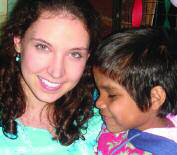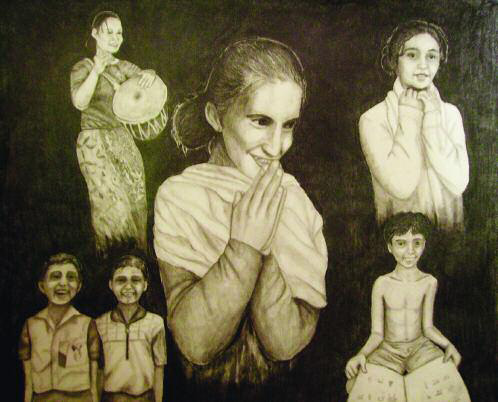
We never know when one small incident will change lives. It was reading a National Geographic article one September afternoon during my sophomore year at Vanderbilt that changed mine.
Reading the article “Twenty-First Century Slaves” in my dorm room that day, I was horrified and heartbroken to learn there are an estimated 27 million slaves in the world today, and that 800,000 to 900,000 are trafficked across international borders each year. I decided at that moment I had to do something.
I began by gathering a group of students and establishing a student organization, FREE, to raise awareness of human trafficking. During months of research I found photos of children and young women who had been rescued from human trafficking.
Two in particular captured my attention. The warmness of their gaze seemed to assure me that they, these girls, were the reason I must continue the anti-trafficking work that by then was consuming my life. The two girls in the photograph had been rescued from slavery somewhere in a town in India known as Allahabad. Suddenly, I felt the need to sketch these girls into a drawing of Freedom.

Each day as I drew, I was surprised at the images making their home on my paper. I noted that of the six figures in my collage, five of them were from India, a land I could only dream of visiting. Little did I know that within only a few months, I would be selected by the U.S. Department of State for an internship in New Delhi, India, with the Trafficking in Persons Office.
When I packed my suitcase, I included a few prints of my finalized drawing.Maybe, just maybe, I would be able to trace the young girls who had inspired me.When I arrived in Delhi in June of 2005, I showed the drawing to my director. She suggested I meet with Joy Zaidi,who ran a shelter home in Allahabad and would be coming to New Delhi the following week.
One week later I sat down with Joy as he told me about the shelter home and HIV/AIDS program he had begun some years before. As he spoke he dabbed his moist eyes, telling me about children for whom he could find no financial support.Many had been abandoned at the train station, or left to begging rackets on the streets, or rescued from forced child labor, or had been victims of trafficking. The small grant that kept the home open had run out. I promised him I would do what I could to find funding for the SOUP (Society of Underprivileged People) home.
Then I unrolled my drawing and handed it to Joy.”Do you know these two girls? Are they from your shelter home?” I pointed to the girl in the center and the girl in the right hand corner. Joy’s eyes filled with tears again. “Oh, yes.Yes, these are my girls! It is my Sunita. And the other, she is our precious Grace Malla!”
A year after I met Joy, I finally had the chance to visit the shelter home. Following my graduation from Vanderbilt in May 2006, I returned to India to work in Calcutta with two organizations, and at long last I could meet the children in the shelter home.
On the way to the shelter from the train station, Joy told me stories about the children: Kajal, a 4-year-old girl found at the train station, had been blinded with acid by her stepmother. Surendra was trafficked for child labor and sold to drug peddlers who cut off his left leg. Rahul had been trafficked for the removal of one of his kidneys.
When I arrived at the shelter, the children greeted me with curious, wide eyes–Rinki, Madhu,Ragni, Rita, Sunny,Gautam,Ramesh, Raoul, Surendra, Kajal. I bent down to take Kajal’s hand, for she was the smallest. Looking at her damaged eyes stopped a beat ofmy heart.
The children wanted to play in a nearby park. Rinki, Ramesh and Madhu never left Kajal’s side. Not once did they run ahead to climb the slide or join a game without taking her hand and gently leading her so she too could take part in the fun. The other children took special care to include Surendra in the games despite the limitations of his short wooden leg. They were a family, a team who took care of each other.
While the children slept around me that night, I feared what would happen if we did not find funding quickly.Would they be left to the streets? The rent was months overdue. Funds were so low that the children had no milk to drink.
In the past, worries could pull and push me into a frenzied panic. But these children had, in only one day, taught me a beautiful lesson. If these children who had lived through slavery, abuse, abandonment and pure evil could live each day with a simple faith, finding joy in helping each other, then so could I.My resolve was steadfast, and I was determined to find funding for those children and, if possible, special help for Kajal and Surendra.
A few months later, at Christmas, I once again journeyed to the shelter home.After I had sent out a call for help, family and friends had contributed to SOUP so that overdue debts could be paid in full. Vanderbilt students from FREE raised $4,500 in three weeks–enough to support the home for five or six months.My mother’s and sister’s Sunday school classes raised enough money for Christmas presents for the children, and there was enough money left over for Surendra to be standing proud and tall on a new leg specially made to fit him.
Now, a small voice called out to me.”Ashley di-di, English song?” Kajal tugged at my shirt.
Kajal wanted me to sing her English songs because she would be going to America for sight restoration surgery.My e-mail call for help had found its way to Jenna Ray from Nashville,who enlisted the help of Dr.Ming Wang. Dr.Wang had developed exactly the surgery Kajal needed in order to see–a femtosecond artificial cornea transplant. He offered to perform the surgery for free and even obtained a grant from the hospital.
But we still needed $30,000 to pay for months of hotels, food, transportation, passports, visas and airfare for Kajal and Joy’s wife,Grace,who would go with her as a translator and caretaker. Kajal’s story went out, and help poured in.Within weeks dozens of families in Nashville had offered to take Kajal and Grace into their homes. People donated to the “Kajal Project,” contributing enough for Kajal and Grace to pay for their passports and visas and needs once in the U.S.
Most amazing was how we obtained Kajal’s and Grace’s airfare.My mother had gone to a Wal-Mart in Monroe, La., to find a USB drive for downloading photos of the children. She did not really know what she needed, but another customer, a man named Curt Gober, offered his help.My mom shared the story of the shelter home and Kajal. Mr. Gober decided at that very moment that he and his family wanted to be part of this project by donating the airline tickets. As he walked away, he turned and said, “Mrs. Rogers, I’m for real, and I am going to do this.”And he did–a stranger from another city passing through town, in Wal-Mart, on the same aisle at the same time as my mom.
My smile was uncontainable that Christmas Eve as I watched Kajal play her favorite game with the other children–creating patterns and networks out of hands. One by one she took the children’s right hands and placed them beside each other before taking their left hands and laying them in a stack. “Ashley di-di, give me your hand,” sang out Kajal. Kajal stood in the middle and began turning so that we all moved in a circle around her.
Kajal is right, I concluded, as I watched her form a web of connections, complete only when she had used both hands from every person in the room.We are all connected, and we all have a part to play, hands to give. While I had worried about how Kajal would find the support she needed to journey to the U.S. for surgery, all I had to do was play a small role by giving my hands and heart, and God did the rest by forming an intricate network of people who gave a “hand” from all over the world.
In July 2007, Kajal had her first reconstructive surgery on her right eye in Nashville. Dr.Wang believes she has a 50 percent chance of regaining sight. Her story has touched many lives, and we hope it may bring help to other children.
Sunita and Grace Malla, the girls whose pictures I had drawn early in my journey, have passed away. Sunita died in June 2006 of a fever. Grace Malla died in 2005 after a battle with AIDS. This is dedicated to them– this article, this project, this lifelong mission. When I drew their picture three years ago, it was not me drawing the story; they were drawing me into their story. Thank you, girls. This story is yours.